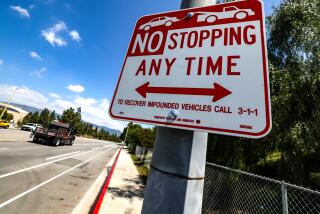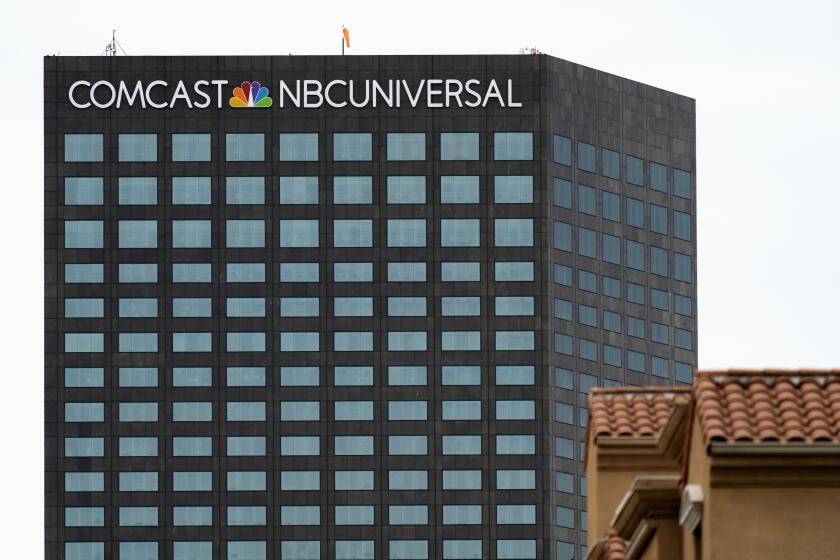Sales of RVs careen off the road
Many Americans still can’t wait to get on the road again. They just can’t afford it.
Buying a motorized or towed recreational vehicle has become a daunting prospect for those who long to see the country at their own pace while surrounded by their own living space.
Financing has dried up as quickly as the equity in many homes -- the kind without wheels. Some people who might have the means to buy an RV are loath to commit $40,000 to $280,000 on a depreciating asset in a dismal economic climate. And the prospect of spending $315 to $675 to fill up a vehicle that gets seven miles per gallon isn’t a big draw, either.
The evidence was on clear display in the latest quarterly earnings report from one of the nation’s biggest RV manufacturers, Fleetwood Enterprises Inc. of Riverside.
Although the company swung to a profit, Fleetwood got there with the help of one-time asset sales and severe cost cutting. Sales of the company’s recreational vehicles and manufactured homes were sharply lower, even though Fleetwood enjoys the kind of fierce customer loyalty that would make the Big Three automakers swoon.
The combined effects of record fuel prices, tight loan credit, consumer anxiety and the real estate collapse have made this the worst time for RV manufacturers in nearly three decades.
“There’s really nothing good happening in this industry,” said Christian Eddleman, an analyst with Argus Research. “It’s rare that someone has to go out and buy an RV. It’s the definition of a discretionary purchase.”
The luxury vacation-on-wheels giants include Fleetwood; Thor Industries Inc. of Jackson Center, Ohio, which carries the familiar Airstream brand; Winnebago Industries Inc. of Forest City, Iowa; Coburg, Ore.-based Monaco Coach Corp.; and Coachmen Industries Inc. of Middlebury, Ind. As a group, they are struggling to jump-start sales and surviving on old orders to keep factories going, analysts said.
Steep decline
In the first four months of this year, purchases of motorized recreational vehicles fell 26% nationally, to 11,860 from 16,065 in the same period a year earlier, according to Statistical Surveys Inc. of Grand Rapids, Mich., which tracks new-vehicle sales for the RV industry. Purchases of trailers, which are less expensive, were down 16% in the first four months of 2008 compared with the same period last year, to 67,167 from 80,342.
California has long been the most important state to the RV industry. About 80 years ago, its enviable climate and scenic vistas made it a popular destination for a growing number of Americans eager to hit the road and explore, according to a new exhibit at the Petersen Automotive Museum in Los Angeles called “From Autocamps to Airstreams -- The Early Road to Vacationland.”
But sales this year have fallen even more steeply in the Golden State. Motorized RV and trailer purchases in California dropped 33% and 34%, respectively, compared with the first four months of last year.
RV salespeople have had to travel back to 1979-81 to find some solace, said Tom Walworth of Statistical Surveys. Those were years when the industry was decimated by fuel rationing, the shift to lower-powered and higher-mileage vehicles, the 55 mph speed limit and other factors. The early 1990s weren’t great, either.
“People call up and ask me, ‘Is this as bad as 1981?’ At least I can tell them, no, it’s not that bad,” Walworth said.
Several factors are causing sales to stall.
Consumer loans for RVs costing $40,000 to more than $200,000 have dried up, as have the separate financing options once available from dealers, Eddleman of Argus Research said.
The popular purchase method of drawing from home equity is largely gone. And, Eddleman said, the costs of just about every important part used in the manufacturing of an RV, from the steel to the copper to the petroleum-based plastics, have soared.
“It’s a really terrible environment” for anyone trying to sell an RV and for anyone who would want to buy one, he said.
Katherine I. Thompson, director and senior equity analyst for investment firm Avondale Partners of Nashville, said the extent of the slump was there to see during a recent tour of RV manufacturing facilities: plants idle for longer than usual, fewer reorders from RV dealerships and higher costs for materials.
The tour reinforced Avondale’s belief that “the RV industry slump could eclipse the early ‘90s 28-month downturn,” Thompson wrote in a note to clients.
No one is ready to predict the end of the line for RV-ing.
Dick Messer, director of the Petersen Automotive Museum, noted that the industry had been through worse periods, such as when World War II diverted the majority of the nation’s manufacturing to the war effort.
After the war, Messer says, factories retooled and began building RVs again. The industry can change again with the times, he says.
“One way is to build more efficient motor homes and more efficient trailers, more lightweight vehicles,” Messer said. “They could use more exotic materials like carbon fiber, more aluminum, to make them more efficient.”
Venturing out
Until that happens, or until the economy and fuel prices return to more familiar territory, those who managed to buy their RVs before the bubble burst will still be keeping the dream of the road alive.
RV owners have cut back on the number of trips they take and the number of miles they travel, but they consider their investment too large to simply leave parked and unused.
Mike and Kathy Sexton of Yuba City, Calif., are as much a Fleetwood couple as you’ll find anywhere. He’s president of the California arm of the Fleetwood Travelcade Club and she’s its secretary-treasurer.
Mike, a 63-year-old semi- retired attorney, isn’t fond of travel that doesn’t involve his 38-foot, diesel-powered Fleetwood Revolution.
“Candidly, it is just a pain in the butt,” he said. “You have to carry your luggage in and out several times. You’re sleeping on beds other people have slept on.”
Sexton says that he and his wife have found attendance at group gatherings to be off quite a bit. “We used to have 300 to 400 members showing up to some events. We’re now down to about 100.”
But the Sextons don’t plan to give up their RV lifestyle.
“We really like having our own place when we travel,” he said. “You go at your own pace. I’d still recommend it.”
That sentiment was in evidence at Bolsa Chica State Beach in Huntington Beach on a recent weekday evening.
With the ocean to the west and the Bolsa Chica Ecological Reserve just across Pacific Coast Highway, the RV park in between was filled with serene vacationers.
Most of them were from Southern California, reflecting the fact that many RV owners were traveling much shorter distances because of the fuel prices.
“We used to go to places six to eight hours away, up to June Lake and the Bishop area,” said 61-year-old Richard Alvarez, a retired Eastman Kodak Co. worker who lives in Whittier with wife Lucy and daughter Cassandra. They own a 2006 Fleetwood Bounder.
“Now, we come to the beach here, and we’ll maybe go as far as Santa Barbara. We’ll only take the shorter trips because of the cost of fuel,” he said.
“Whatever sacrifice we have to make, we’re still going to drive it.”
--
More to Read
Inside the business of entertainment
The Wide Shot brings you news, analysis and insights on everything from streaming wars to production — and what it all means for the future.
You may occasionally receive promotional content from the Los Angeles Times.











